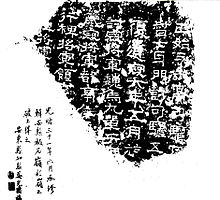Guanqiu Jian
Guanqiu Jian | |
|---|---|
| 毌丘儉 | |
| General Who Guards the East (鎮東將軍) | |
| In office 252 – 16 March 255 | |
| Monarch | Jing Province (荊州刺史) |
| In office ?–? | |
| Monarch | Cao Rui |
| Personal details | |
| Born | Unknown Wenxi County, Shanxi |
| Died | 16 March 255[a] Feidong County, Anhui |
| Relations | Guanqiu Xiu (brother) |
| Children |
|
| Parent |
|
| Occupation | Military general, politician |
| Courtesy name | Zhonggong (仲恭) |
| Peerage | Marquis of Anyi (安邑侯) |
Guanqiu Jian (died 16 March 255),[a] courtesy name Zhonggong, was a Chinese military general and politician of the state of Cao Wei during the Three Kingdoms period of China.
Life

Guanqiu Jian was from Wenxi County (聞喜縣), Hedong Commandery, which is present-day Wenxi County, Shanxi. His father, Guanqiu Xing (毌丘興), served as the Administrator of Wuwei Commandery (武威郡) under the Cao Wei state and held the peerage "Marquis of Gaoyang District" (高陽鄉侯). After his father's death, Guanqiu Jian inherited his father's peerage and served as a clerk to the Marquis of Pingyuan (平原侯).
In 226, after
In 237, Guanqiu Jian led an army to
In 244, Guanqiu Jian led a
In 255, Guanqiu Jian and
Name
Guanqiu Jian's name is often read as Wuqiu Jian (毋丘儉), and appears as such in Volume 73 of Sima Guang's Zizhi Tongjian. However, Wu Jinhua (吳金華) argued that the original reading was Muqiu (母丘; also alternatively written as Wuqiu 毋丘 and Manqiu 曼丘), and that Guanqiu (毌丘) was a later transcription error dating back to the Tang and Song dynasties. He supports his argument with the occurrence of Muqiu as a family name on a tomb stele from the Three Kingdoms period and also in the Ri Zhi Lu (日知錄) by early Qing dynasty scholar Gu Yanwu; as well as the occurrence of Wuqiu as a surname on an ancient seal and a bamboo strip from the Yinwan (尹灣) Han-period tomb excavated in 1993. Wu also points out that a general named Manqiu Chen (曼丘臣) is mentioned in the second part of Emperor Gao's biography in the Book of Han, and that an annotation by the Tang dynasty historian Yan Shigu mentions that "Manqiu and Muqiu were originally the same family name".[2]
See also
Notes
- ^ a b Cao Mao's biography in the Records of the Three Kingdoms recorded that Guanqiu Jian died on the jiachen day of the leap month of the 2nd year of the Zhengyuan era of Cao Mao's reign.[1] This date corresponds to 16 March 255 in the Gregorian calendar.
References
Sources
- Chen, Shou (3rd century). Records of the Three Kingdoms (Sanguozhi).
- Annotations to Records of the Three Kingdoms(Sanguozhi zhu).
- Wu, Jinhua (2001). "Sanguo Zhi Jiaoyi Xuli" (三國志斠議續例). Wenshi (文史).
